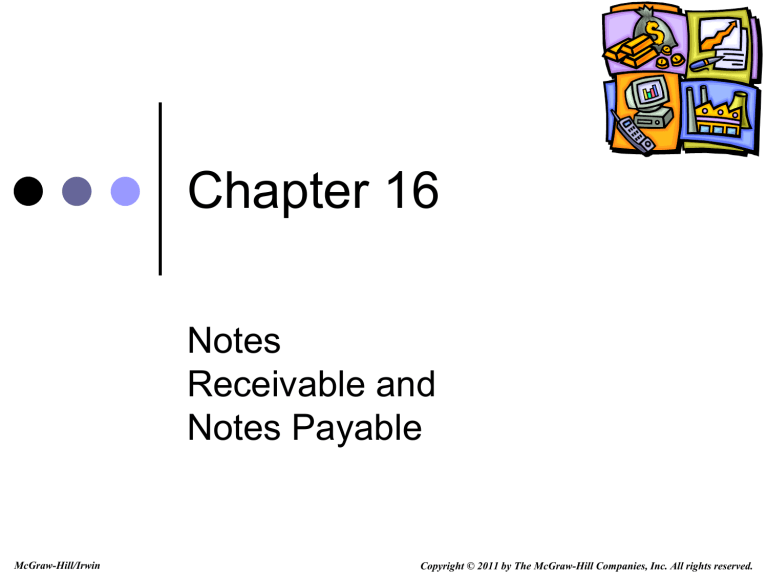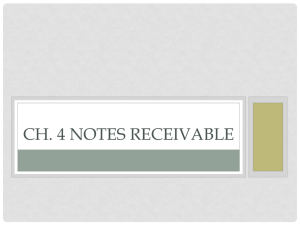
Chapter 16
Notes
Receivable and
Notes Payable
McGraw-Hill/Irwin
Copyright © 2011 by The McGraw-Hill Companies, Inc. All rights reserved.
LO1
Learning Objective 1
Describe a promissory note.
A promissory note is a written promise to pay a specified amount of money, usually
with interest, either on demand or at a definite future date.
$1,000.00
Term
July 10, 2011
Payee
Ninety days
after date I promise to pay to
thePrincipal
order of Barton Company, Los Angeles, CA
One thousand and no/100 --------------------------------- Dollars
Payable at
First National
InterestBank
Rateof Los Angeles, CA
Maker
12% per annum
Value received with interest at
No.
42
Due Oct. 8, 2011
Julia Browne
Due Date
16-2
LO2
Learning Objective 2
Compute the maturity date and interest due on a promissory note.
On March 1, 2010, Matrix, Inc.
purchases a copier for $12,000 from Office Supplies, Inc. Matrix gave
Office Supplies a 9% note due in 90 days in payment for the copier.
What is the maturity date of the note?
Days in March
Minus the date of the note
Days remaining in March
Days in April
Days in May to maturity
Period of the note in days
31
1
30
30
30
90
In this example, we
add 30 days in
March, 30 days in
April, and 30 days in
May to add up to the
note term of 90 days.
The note is due and payable on May 30, 2010.
How much interest will Matrix pay to Office Supplies, Inc. on this note?
Principal
of the
note
$ 12,000
×
Annual
interest
rate
×
9%
×
Time
expressed
in years
=
Interest
×
90/360
=
$
270
16-3
LO3
Learning Objective 3
Record the receipt of a note receivable.
On
Here
May
are30,
the2010,
entryOffice
on March
Supplies,
1, 2006,
Inc.toreceives
record
the principal
the sale
amount
and of
note
thereceivable.
note plus interest.
Mar. 1
Notes Receivable
Sales
DR
12,000
CR
12,000
Sold goods in exchange for note
DR
12,270
May 30 Cash
Interest Revenue
Notes Receivable
CR
270
12,000
Collected note and interest due
16-4
LO4
Learning Objective 4
Record the honoring, discounting, and dishonoring of a note and
the adjustment for interest.
On March 31, 2010, Office Supplies decides that it needs cash and cannot hold
the note any longer. The company goes to First National Bank and discounts
the note at 12%. The bank pays Office Supplies cash and deposits the
amount in its checking account.
Step 1: Calculate the maturity value of the note.
Maturity
value = Principal + Interest due at Maturity
Maturity
value = $12,000 + $270 = $12,270
Step 2: Determine days in discount period.
Days in April
Days in May to maturity
Days in discount period
30
30
60
16-5
LO4
Note Discounted before Maturity
Step 3: Compute the bank discount charge.
×
Discount
Maturity
Discount
=
×
Charge
Value
Rate
Discount
Period
Discount
= $12,270 × 12% × 60/360 = $245.40
Charge
Step 4: Compute proceeds from the discounting.
Proceeds = Maturity Value – Discount Charge
$12,024.60 = $12,270.00 – $245.50
16-6
LO4
Note Discounted before Maturity
Let’s look at the journal entry to record the discounting of the note receivable.
Cash
12,024.60
Interest revenue
Notes Receivable
24.60
12,000.00
To record discounting of note receivable
Now let’s assume that Office Supplies held the note to maturity. At maturity, Matrix
informs Office Supplies that it is unable to pay the note or interest. The note has
matured and is no longer valid.
Accounts Receivable - Matrix
Interest revenue
Notes Receivable
12,270
270
12,000
To charge accounts receivable for dishonored
note
16-7
LO4
Accrued Interest on Notes Receivable
Using the same purchase of a copier example between Matrix and Office Supplies, Inc.
that we just reviewed, let’s change the date of the note to December 1st instead of
March 1st.
On December 1, 2010, Matrix, Inc. purchases a copier for
$12,000 from Office Supplies, Inc. Matrix issues a 9% note
due in 90 days in payment for the copier. What adjusting
entry is required on December 31, year-end of Office
Supplies?
$12,000 × 9% × 30/360 = $90
Dec. 31 Interest Receivable
Interest Revenue
DR
90
CR
90
To accrue interest on note
16-8
LO4
Accrued Interest on Notes Receivable
Let’s look at the entry Office Supplies, Inc. will make
on March 1st.
Mar. 1
DR
12,270
Cash
Interest Receivable
Interest Revenue
Notes Receivable
CR
90
180
12,000
To record full payment of note
16-9
LO5
Learning Objective 5
Prepare entries to account for notes payable.
On March 15, 2010, Western, Inc. issues a $10,000, 12%, 90-day note to
First Bank for cash. Let’s make the journal entry.
Date
Description
Mar. 15 Cash
Notes Payable
Debit
Credit
10,000
10,000
To record note issued for cash
Let’s calculate interest to maturity.
$10,000 × 12% × 90/360 = $300
Date
Description
Jun 14 Notes Payable
Interest Expense
Cash
Debit
Credit
10,000
300
10,300
To record payment of note
16-10
LO5
Discounting a Note Payable
On March 31, 2010, Webb Co. discounts its $40,000, 6%, 90-day note at
First Bank for cash. Let’s make the journal entry.
Interest to Maturity
Date
$40,000 × 6% × 90/360 = $600
Description
Debit
Mar. 31 Cash
Interest Expense
Notes Payable
Credit
39,400
600
40,000
To record discounting notes payable
Date
When the note matures
on May 30th, Webb
makes the following
journal entry.
Description
May 30 Notes Payable
Cash
Debit
Credit
40,000
40,000
To record payment of note
16-11
LO6
Learning Objective 6
Explain the types and payment patterns of notes.
An installment note requires a series of payments over the life
of the note rather than one payment at maturity.
On January 1, 2010, Gear, Inc. signs a $60,000 note to First Bank. The
note bears interest at 10% annually and requires payments of $15,827.85
at the end of each of the next five years.
Year
Note Payment Schedule
Interest
Payment
Principal
Balance
$
1
2
3
4
5
$
Date
15,827.85
15,827.85
15,827.85
15,827.85
15,827.85
$
6,000.00
5,017.22
3,936.15
2,746.98
1,438.90
$
Description
Dec. 31 Notes Payable
Interest Expense
Cash
60,000.00
50,172.15
39,361.52
27,469.82
14,388.95
-
9,827.85
10,810.63
11,891.70
13,080.87
14,388.95
Debit
Credit
9,827.85
6,000.00
15,827.85
To record first payment on note
16-12
Learning Objective 7
LO7
Compute the interest times earned ratio and use it to
analyze liabilities.
When a company has long-tem liabilities, lenders
want to know if there will be sufficient earnings to pay
interest as it comes due. Lenders can use this ratio to
help decide if they should accept the risk.
Experience shows that when times interest earned
falls below 1.5 to 2.0 and remains at that level or
lower for several periods, the default rate on
liabilities increases sharply.
16-13
End of Chapter 16
16-14


